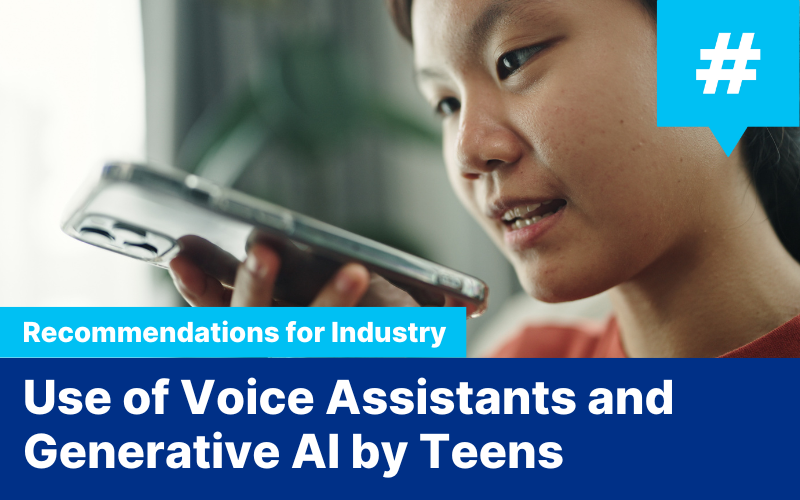AI-powered tools such as Voice Assistants (VAs) and Generative AI (GenAI) are becoming deeply integrated into young people’s lives, shaping how they learn, create, and interact with the world. In our latest Pulse Survey: Optimism and Uncertainty – How Teens View and Use Artificial Intelligence, we explored how teens are navigating the many opportunities and challenges that come with using AI tools.
The following recommendations for developers, designers, and policy makers of commercial AI-powered tools are drawn from what we learned.
Draw a Clear Line Between Trusted Friend and Tool
Many teens who responded to our survey see GenAI as something that can act like a friend and could even take the place of spending time with real people. More research is needed to understand the long-term impacts—both positive and negative—of youth forming relationships with non-human agents.
- Prioritize designing AI systems that support healthy human relationships, creating tools that help young users view AI as a tool rather than a substitute for human interaction. As a general guideline, AI agents designed to foster emotional connections or relationships with users should not yet be made available to young audiences.
- Build in prominent features that emphasize AI’s status as a computer, helping users recognize AI as a non-human tool.
Support Responsible AI Use Through Digital Education
Teens report that they tend to trust the information they get from AI tools, yet most also worry about how accurate the information might be. Over half of respondents shared that they aren’t receiving the education they need to adequately assess the veracity and authenticity of information accessed through AI-enabled tools. Over two-thirds of teens reported that they want to talk more about how to use AI responsibly, a knowledge gap that can be filled through compulsory and comprehensive tech education.
- Embed clear, easy-to-understand, obvious explanations about AI accuracy and bias directly into tools and AI-enabled platforms. Explanations should offer recommendations to users to check the accuracy of the information they receive and provide educational tools about digital literacy and how AI operates.
- Simplify cross-referencing methods for users by citing sources in live links in AI platforms and tools to well-regarded, unbiased sources of information, as well as basic prompts for building digital literacy approaches and skills.
Foster Ethical AI Practices
Teens reported that they are growing more worried about how GenAI could be misused with harmful consequences, particularly with deepfakes, privacy breaches, mis- and dis-information, and scams. Many respondents reported that they believe that tech companies and teen users share the responsibility in making sure AI-enabled spaces provide safe and positive experiences.
- Implement clear, teen-friendly privacy policies that explain exactly what data is being collected, how it’s used, and how teens can control their privacy settings. Make privacy features easily accessible and customizable, allowing teens to opt in or out of data-sharing options. Consider defaulting teen users to higher privacy and protection settings at registration and offer a walkthrough of settings and safety considerations as part of onboarding.
- Empower teen users to engage with their natural curiosity and skepticism, to question what they see or read, and provide them with tools to follow up on this inquiry. Integrate fact-checking features and/or credibility indicators directly into AI-powered tools. This could include alerting users when AI-generated content is likely to be inaccurate or biased, and providing recommendations for additional vetted sources for more information.
- Strengthen policies and community guidelines to include deepfakes and digitally altered content.
- Collaborate across the industry, and with user advocacy and awareness groups, to offer users regular updates on emerging threats related to AI misuse, helping them to stay informed and aware of new risks.
Design opportunities for teens to be part of building and maintaining the safe and pro-social communities they want to be a part of. This can include engaging with teen councils, empowering teens to use blocking and reporting tools as necessary (and following up to transparently share what happens after they block or report), and providing teens with options to co-design AI products and tools that align with their needs, concerns, and expectations.








